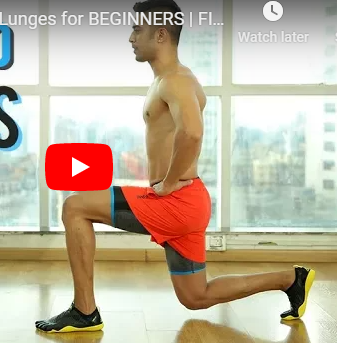Lunges are a popular exercise that target the muscles in your legs and glutes. Here’s how to do a basic lunge:
- Stand with your feet hip-width apart and your hands on your hips.
- Take a big step forward with your right foot and lower your body until your right thigh is parallel to the floor. Your left knee should be bent and hovering just above the ground.
- Pause for a second, then push through your right heel to return to the starting position.
- Repeat on the other side by stepping forward with your left foot.
Here are some tips to keep in mind when doing lunges:
- Keep your chest lifted and your shoulders relaxed.
- Make sure your front knee is directly above your ankle, and that your back knee is pointing towards the ground.
- Engage your core muscles to help stabilize your body.
- You can hold weights in your hands or wear a weight vest to make the exercise more challenging.
- If you have knee or joint pain, try a modified lunge where you step forward onto a platform or bench, which will reduce the amount of bend in your knee.
Lunges can be a great addition to your workout routine to build strength, improve balance and coordination, and increase flexibility.
There are many variations of lunges that you can try to target different muscles and add variety to your routine. Here are a few examples:
- Walking lunges: Instead of stepping forward and then returning to the starting position, take multiple steps forward with each lunge.
- Reverse lunges: Start by taking a step backward with one foot and lowering your body until your back knee is hovering just above the ground. Push through your front heel to return to the starting position and repeat on the other side.
- Side lunges: Take a big step to the side with one foot, keeping the other foot planted. Lower your body until your bent knee is parallel to the ground, then push through your heel to return to the starting position. Repeat on the other side.
- Jumping lunges: Start in a lunge position, then jump up and switch legs in mid-air, landing in a lunge position on the opposite side. This is a more advanced exercise that requires coordination and balance.
When doing lunges, it’s important to listen to your body and make adjustments as needed. If you experience pain or discomfort, stop the exercise and consult with a healthcare professional or certified trainer. Start with a few repetitions and gradually increase the intensity and duration of your lunges as your strength and fitness level improves.
In addition to the benefits mentioned earlier, lunges can also help improve your posture and increase your range of motion. They can also help prevent injury by strengthening the muscles around your joints.
Incorporating lunges into your workout routine is easy and can be done anywhere without any equipment. You can do lunges as part of a bodyweight workout or add them to a lower-body strength routine. You can also use lunges as a warm-up exercise before other activities, such as running or sports.
As with any exercise, it’s important to maintain proper form when doing lunges to avoid injury and get the most benefit from the exercise. Take your time, focus on your form, and gradually increase the intensity of your lunges as you get stronger. Don’t forget to stretch before and after your workout to help prevent injury and reduce muscle soreness.
Overall, lunges are a versatile exercise that can help you build strength, increase flexibility, and improve your overall fitness level. Whether you’re a beginner or an experienced athlete, adding lunges to your workout routine can help you reach your fitness goals.
Incorporating lunges into your workout routine can also help you target specific muscles in your legs and glutes. For example:
- Forward lunges primarily target the quads (front of the thigh), glutes, and hamstrings (back of the thigh).
- Reverse lunges place more emphasis on the glutes and hamstrings.
- Side lunges target the inner and outer thighs, as well as the glutes.
- Walking lunges are a great way to work on endurance and target all of the major muscles in the legs and glutes.
- Jumping lunges can help improve explosive power and work on fast-twitch muscle fibers.
To make lunges more challenging, you can add weight, such as holding dumbbells or using a barbell across your shoulders. You can also add in variations, such as twisting your torso or adding a knee lift at the top of the lunge.
In summary, lunges are a great exercise to add to your workout routine to improve your overall strength and fitness level. There are many variations of lunges to choose from, so you can mix and match to target different muscles and keep your workout interesting. As with any exercise, it’s important to listen to your body and make adjustments as needed to avoid injury and get the most benefit from the exercise.
27 total views , 1 views today
